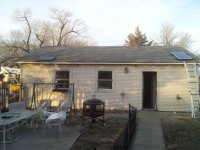run a google search "solar angle" there are several sites and softwares the you can punch in your location, and it will give you the solar path for the year as well as any given day, most installs pick an average so you can get decent output throughout the year,
my take on it is that solar the way is comercially done is outrageous, too complicated and too expensive to make sense, first you need to look at your load and start cutting back if there is as much as one incandecent bulb in your house you are not ready for solar yet.
second, the whole concept of having all apliances run on 115v ac is centralisation at its finest, it does not go well with self sufficient, for example lighting LED's run at aprox 3.5v dc, the comercial ones at HD have a power supply built in to feed them from the 115v line therefore they are prohibitively expensive, further more most solar panels have an open voltage rating of 18 v pretty standard stuff to charge a standard 12v lead acid batery, comercially that gets inverted to 115v and than the LED's power supply turns it back to 3.5v, so much for efficiency and all that equipment is not cheap.
one project I want to do is have my lights rewired for LED's solar power totally separated from the grid and the rest of the house, the concept is to make my own solar panels, I saw it done for savings sake but the reason I am interested in it:
a solar cell has 0.5v nominal output in full sun, normally they arange them in series to get the 18 v, about 36 of them, if you build your own you could do a 10S for a nominal 5v open circuit, this should be just right to charge say a 20 AH lifepo4 which ranges between 3.2v to 3.6 v perfect for LED lighting, I was planning on ordering lots of bright White LEDs and make my own lights, I even ment to start a thread but been bit bussy, maybe you can take it from here, the Idea is to have totally sustainable lighting completely off grid and they would last forever, it should also eliminate the need for inverters and expensive comercial LEDs,
further more there are refrigerators that run on 24v dc and camper microwaves, I was looking at the nuwave induction cookers, your laptop could be charged directly on solar your LED tv has a built in power supply I am pretty sure it runns on low voltage DC, I am planing a new house build where the entire electric will be thought out in this manner, no sense generating PV 12v DC run it through expensive inverters and large battery banks and then stepped down to DC again to run a laptop, a more decentralised aproach would be a lot more cost effective, you should put your money toward more pannels rather than inverters and charge contollers
just my take on it.
George



